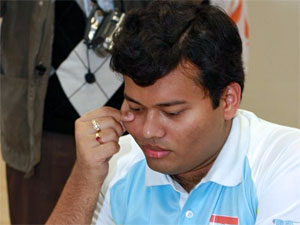Surya Shekhar Ganguly annotates
In the first part of our interview with Surya Shekhar Ganguly we had promised to bring you three games annotated by the Indian GM. They are his favourite from his one-month tour where he played 27 games in three different events. These games have been meticulously annotated by the 2627 player and he has revealed many interesting points not only related to calculations and analysis but also with human psychology, preparation and playing under pressure in crucial games.
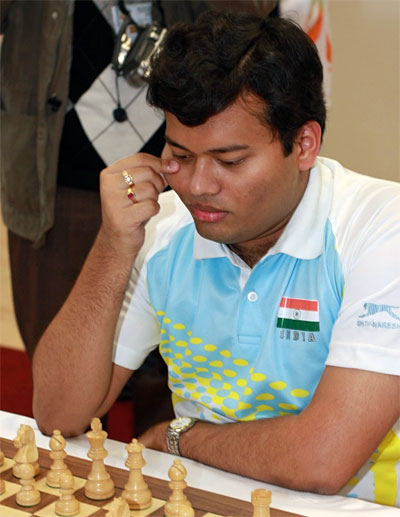
GM Surya Shekhar Ganguly
Lovers of the game can go over Ganguly’s analyses on our JavaScript boards or download the PGN and have a look at them on their ChessBase software. For ambitious players, however we recommend the latter. But before going through the analyses, you can spend ten minutes on the two test positions given at the beginning of each game. Write down your analysis and then go over the game on a chess board. This might be time consuming, but you are effectively receiving lessons from a 2600+ GM.
Ganguly vs Ortiz Suarez, final round of Kolkata Open 2014

Position after 26...Bf6. Black threatens the strategic idea of play e5-e4
and exchanging the dark squared bishops. How did Ganguly react to this threat?
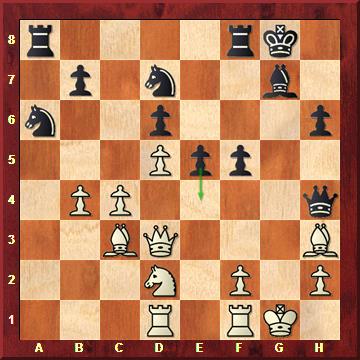
Position after 29...gxf5. Taking the f5 pawn doesn’t really work here
because of Qg5+, and e5-e4 is threatened. What does White play?

[Event "LIC 2nd GM Open"] [Site "Kolkata"] [Date "2015.03.24"] [Round "9"] [White "Ganguly, Surya Shekhar"] [Black "Ortiz Suarez, Isan Reynaldo"] [Result "1-0"] [ECO "B92"] [WhiteElo "2603"] [BlackElo "2625"] [Annotator "Surya Shekhar Ganguly"] [PlyCount "99"] [EventDate "2015.03.16"] [EventRounds "9"] [EventCountry "IND"] {Before last round of Kolkata open there were three players leading with 6.5/8. Nigel Short was playing with the other leader Lu Shanglei while I was downfloated and paired with Ortiz. I was very pleasantly surprised to see that I got double white and decided not to file an objection for the same :)} 1. e4 {I noticed Ortiz mainly plays Najdorf in which I have tried almost everything and he mainly likes to play the e6 lines} c5 2. Nf3 d6 3. d4 cxd4 4. Nxd4 Nf6 5. Nc3 a6 6. Be2 {He mainly plays 6...e6 here but in this particular tournament he had a game with 6...e5. I decided to opt for a comparatively lesser known line.} e5 {as expected} 7. Nb3 Be7 8. O-O O-O 9. Be3 Be6 10. Qd3 ( 10. Nd5 {is another way to reach similar kinds of lines, but this also allows an extra 10...Ne4 option for Black.}) 10... Nbd7 11. Nd5 Bxd5 12. exd5 h6 {Not so sure if this move is required. Black shows his kingside structure too early. Its not clear if this would be the most useful move.} (12... Rc8 {is the famous handshake game!} 13. c4 a5 14. Kh1 Re8 15. Rad1 Bf8 16. Nd2 $14 {1-0 (72) Short,N (2645)-Cheparinov,I (2713) Wijk aan Zee 2008}) (12... Ne8 {[%cal Ge7g5]} 13. Bg4 $1 Nef6 14. Bh3 Re8 15. c4 e4 16. Qe2 Nc5 17. Rad1 Qc7 18. Nxc5 dxc5 19. g3 $14 {Hari played an excellent positional game to beat Dominguez in Wijk 2014}) (12... Nc5 13. Nxc5 dxc5 14. Bf3 Qc7 15. c4 g6 16. Rae1 h5 17. Bg5 $16 {is another instructive game by Nakamura against Topalov from 2013}) 13. c4 a5 14. Rad1 Ne8 {[%cal Ge7g5]} 15. Bg4 $1 {Similar theme to Harikrishna-Dominguez} a4 (15... Bg5 16. Bxd7 $1 {The point!} Qxd7 17. f4 $3 exf4 18. Bxf4 $14 {[%cal Gb3d4]}) 16. Nd2 {I was looking at other moves like Bd7, Nc1, Na1 etc., but at the end this felt the best against Black's main strategic threat of Bg5.} Nc5 (16... Bg5 17. Bxd7 $1 {as usual} Qxd7 18. f4 exf4 19. Bxf4 Bxf4 20. Rxf4 $14 {[%cal Gd2e4]}) 17. Qc2 (17. Bxc5 $5 {was another interesting choice. Both the game continuation and this looked nice and I couldn't be sure which one is more promising. In the end I decided to retain my bishop.} dxc5 18. Rfe1 Nf6 19. Bf5 $1 {The disadvantage of playing early h6 is clear. Now getting g6-f5 would almost be impossible.} Bd6 20. Re3 $14) 17... Nf6 (17... Bg5 18. Bxc5 $1) 18. Bh3 (18. Bf5 $5) 18... Qa5 19. Nb1 { felt normal to get the knight on c3 to control Black's queenside activities.} Nfd7 20. Bd2 (20. Nc3 $1 {was my original intension and I am not sure why I rejected it.} Nb6 21. Nb5 Qb4 22. Rc1 $16 {[%csl Rb4]}) 20... Qd8 21. b4 (21. Nc3 $5) 21... axb3 22. axb3 Bg5 {as per plan.} 23. b4 Na6 (23... Bxd2 {would have perhaps been a better decision.} 24. Nxd2 Na6 25. Rb1 $14 {although white still keeps the advantage}) 24. Bc3 $1 g6 25. Nd2 (25. Na3 $5 Nc7 26. Bb2 $14 { [%cal Gc4c5]}) 25... f5 26. g3 {Just a prophylaxis and to keep the option open for playing f4 if there is too much pressure on c4 due to Bd2 threats} (26. g4 $6 Bf4 $1) 26... Bf6 {[#]Ortiz didn't see any great idea behind g3 (there weren't any indeed – it was just a prophylaxis) and decided to prepare the strategic threat of exchanging dark square bishops with e4.} (26... e4 27. Kh1 $1 {[%cal Gg3g4] and White will prepare g4.}) (26... h5 $5 {might have been the best}) 27. g4 $1 {Right now or never! Suddenly White gets a huge potential king side attack which was seemingly impossible just a few moves back when White was trying to progress on queenside and Black was marching ahead on kingside.} Bg7 {This was more or less the only line which I had to make sure that does not work for black} (27... e4 28. gxf5 Bxc3 29. Qxc3 gxf5 30. f3 $16 {[%csl Rg8][%cal Gg1h1]}) 28. gxf5 Qh4 29. Qd3 gxf5 {[#]} 30. Kh1 $1 {The only trick that had to be foreseen while playing g4.} e4 31. Rg1 $1 Nf6 (31... exd3 32. Rxg7+ Kh8 33. Rxd7+ Rf6 34. Bxf5 $18) (31... Ne5 32. Bxe5 dxe5 33. Qg3 Qxg3 34. Rxg3 Kh8 35. Rdg1 $18) 32. Qg3 {There are other moves too, but this is most forcing.} Qxg3 33. Rxg3 Nh5 34. Rxg7+ $1 Nxg7 35. Rg1 Rf7 36. Nxe4 $1 Nxb4 (36... fxe4 37. Be6 $18) 37. Nxd6 Ra3 {There are plenty of ways to win. I was mainly looking for the one with fewer complications} 38. Bxb4 (38. Rg3 $18) ( 38. Nxf7 $18) 38... Rxh3 39. Nxf7 Kxf7 40. Re1 {The rest is easy.} Rh4 41. Re7+ Kf6 42. Rc7 Kg6 43. d6 Ne6 44. Re7 Nd8 45. d7 Rd4 46. Ba5 Rd1+ 47. Kg2 b6 48. Bxb6 Nb7 49. c5 Nxc5 50. d8=Q {Finally this win got me the championship clearly, as Nigel and Lu Shanglei drew on the top board. I was delighted to win a tournament in my hometown finally!} 1-0
Ganguly vs Palit, Bangkok Open Round 6

Position after 11...a6. White has developed effectively against
the Philidor setup. How should he launch an attack now?
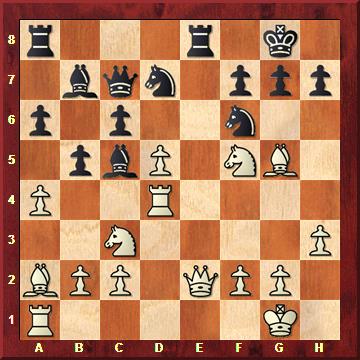
Position after 16...Bc5. White’s queen is attacked on e2 and so is his rook. He needs to
find a way out of this problem. How did Ganguly manage it? Think a few moves ahead.

[Event "Bangkok Open"] [Site "?"] [Date "2015.04.16"] [Round "6"] [White "Ganguly, Surya Shekhar"] [Black "Palit, Somak"] [Result "1-0"] [ECO "C41"] [WhiteElo "2619"] [BlackElo "2415"] [Annotator "Surya Shekhar Ganguly"] [PlyCount "49"] 1. e4 d6 2. d4 Nf6 3. Nc3 e5 {An expected line. Although he plays many other variations somehow I expected he would try to be solid and opt for this one.} 4. Nf3 Nbd7 5. Bc4 {This main line has been recommended by Parimarjan Negi in his wonderful book on 1.e4. Before this tournament I played in Australia where in one of my game I noticed my opponent likes an offbeat system of the French. I knew Parimarjan wrote a very nice book recently but wasn't aware what he recommended in that particular system. It was a double round event and there was hardly any time to prepare, so all I could do was to chat with him on Facebook, and he told me what to do in that particular line. He also said that I should perhaps consider buying his book as it has got many other good stuff as well. When in the game I won almost effortlessly following our Facebook chat I went to the bookstore which was located just outside the playing hall and got the book!! That was very important for this current game......} (5. Be2 Be7 6. g4 {I have played one game like this before, but this time I was well armed with Parimarjan's analyses and his explanations in the book.}) 5... Be7 6. a4 $1 {On the long flight from Sydney to Bangkok I had ample time to flip through the book and I noticed that Parimarjan has spent a lot of time in explaining the finesse of move orders in this system. I don't want to give away all the hard work which he did for his book. I would rather recommend the readers to buy it and go through all the details instead. However I can perhaps mention that starting with a4 bypasses some of Black's systems like ed4-Nb6 etc.} O-O 7. O-O c6 8. h3 $1 {Another important junction: it's important to start with 8.h3 and not 8.Re1 as per the book.} (8. Re1 b6 {is something White wants to avoid.}) 8... b6 {There are of course plenty of other moves that have been analysed, but this is one of the main ones.} 9. Qe2 $1 { So this was one of the main point of Parimarjan for starting with 8.h3. Against b6 he wants to get a Qe2-Rd1 setup.} Bb7 $6 {[%csl Gf5]} (9... a6 10. Rd1 {is another long story, but basically White always keeps some pressure here. The main idea is to have the option of Nh4 whenever Black goes for Bb7.}) 10. Rd1 Qc7 11. Ba2 $1 {To avoid all unnecessary complications in centre.} a6 { [#]} (11... Rfe8 12. Bxf7+ Kxf7 13. Qc4+ $18 {is something I could remember during the game from the book}) 12. Nh4 $1 $16 {At this point my roommate Abhijit Kunte came to board and smiled because just 30 minutes before the game I was explaining to him the move order finesse of Negi's book and this was the exact position I showed! However during the game I could not remember what Parimarjan gave from here onwards. It didn't bother me much, as first of all I was very happy with my position already and my opponent was out of his preparation as well. Later it turned out I had enough reason not to remember the lines as Parimarjan didn't give any! He just said White is better and has great attacking prospects, which is very true.} b5 (12... Rfe8 13. Qc4 $16) 13. Nf5 Rfe8 14. Bg5 (14. dxe5 Nxe5 {is something I didn't want to allow}) (14. axb5 axb5 (14... cxb5 15. dxe5 Nxe5 (15... dxe5 16. Qf3 $16) 16. Bg5 $16) 15. Nxe7+ Rxe7 16. dxe5 Nxe5 17. b4 $14 {This was the most solid approach and perhaps the best, but somehow I was more excited with my attacking chances with 14.Bg5.}) 14... exd4 (14... Bf8 15. dxe5 $1 {Now that Black can't take with knight anymore} dxe5 (15... Rxe5 16. Bf4 $16) 16. Qf3 $18 {is more than +2 already!}) 15. Rxd4 d5 $2 {If it works then Black should be totally fine. But unfortunately it doesn't due to a fine tactical point.} (15... c5 {I was mostly checking this move} 16. Rdd1 (16. Rd3 $5 {Although this looks tempting I wasn't sure how to continue after...} Bf8 $1 17. axb5 (17. Rg3 g6 {leads nowhere and in fact Black is better now.}) 17... c4 {Didn't feel right for White.}) 16... b4 (16... c4 17. axb5 $18) (16... Bf8 $1 {is messy but probably this is Black's best bet.}) 17. Nxe7+ Rxe7 18. Nd5 Bxd5 19. Bxd5 Nxd5 20. Rxd5 $14 {looked pleasant}) 16. exd5 Bc5 {[#]} 17. d6 $1 {Without this move Black could even be better, but now its just lost for him.} Qb8 (17... Qb6 {I was expecting this to happen.} 18. Re4 $1 {Just like in the game} Nxe4 19. Nxe4 Bxf2+ 20. Kh1 $18 {White has simply too many pieces pointing towards Black's king.}) (17... Rxe2 18. dxc7 {also loses} Re5 (18... Bxd4 19. Nxe2 Bxb2 20. Rd1 $18) (18... Ree8 19. Rad1 $1 Bxd4 20. Rxd4 $18) 19. Bxf6 Nxf6 (19... Bxd4 20. Bxe5 Bxe5 21. Rd1 $18) 20. Rd8+ Re8 21. Rad1 $18) 18. Re4 $1 Nxe4 (18... b4 19. Bxf6 Nxf6 20. Qc4 Rf8 21. Qxc5 bxc3 22. Qxc3 $18) 19. Nxe4 {If we go back to move 12 where Parimarjan said White has great attacking chances, White merely had a few pieces towards black's king compared to black's forces there. If we look at the position just seven moves later it is visible that almost all White's pieces are directed against Black's king and Black's pieces are way too far to protect the king.} Re5 {I was sure there must be many ways to win here but felt no harm in taking more time and looking for the shortest and the best continuation.} 20. Qg4 h5 21. Bxf7+ {most forcing and also the strongest} Kxf7 22. Qxh5+ Kg8 (22... g6 23. Qh7+ Ke8 24. Qxg6+ Kf8 25. Bh6#) 23. Nh6+ $1 Kh7 (23... gxh6 24. Nf6+ Nxf6 (24... Kg7 25. Qxh6+ Kf7 26. Qh7+ Ke6 27. Qxd7#) 25. Qg6+ Kf8 26. Bxh6# {would have been a nice finish too}) 24. Ng4+ Kg8 25. Ngf6+ $1 (25. Ngf6+ Nxf6 (25... gxf6 26. Nxf6+ Nxf6 27. Qg6+ Kf8 28. Bh6#) 26. Nxf6+ Kf8 27. Nd7+ Kg8 28. Nxb8 $18) 1-0
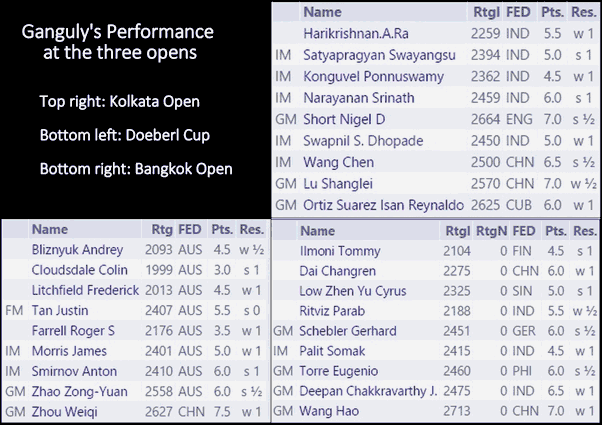
The lists above show all Gagnuly's opponents in each event, their ratings, nationalities,
the points they finished the tournament with, the colour he had and the result.
Sagar Shah, who received the game annotations from Ganguly, writes: "Personally for me, these have been the best annotated games I have seen in the recent times. I cannot stress how much I learnt going over these games with Ganguly’s annotations. I hope you too enjoyed them and learnt a lot. A huge thanks to Surya Shekhar Ganguly for treating the readers of ChessBase with some really high quality annotations."
The final section, with a detailed strategical analysis of Ganguly vs Wang Hao
in the final round of the Bangkok Open 2015, will follow this weekend.
